Max Brosi: The static becomes dynamic
Ireland’s Max Brosi is one of the most inventive woodturners to emerge in recent years, known both for the ingenuity of his designs and for having the technical prowess to bring them to life.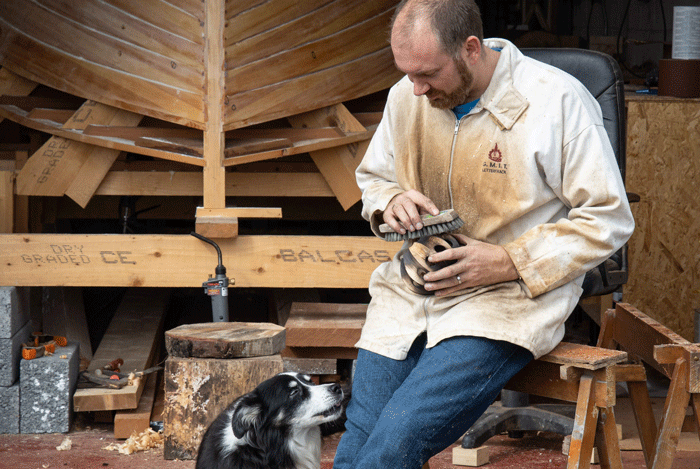
Brought to you by:
This article, “Max Brosi: The Static Becomes Dynamic,” by Roger Bennett, is from the pages of American Woodturner and is brought to you by the American Association of Woodturners (AAW) in partnership with Fine Woodworking.
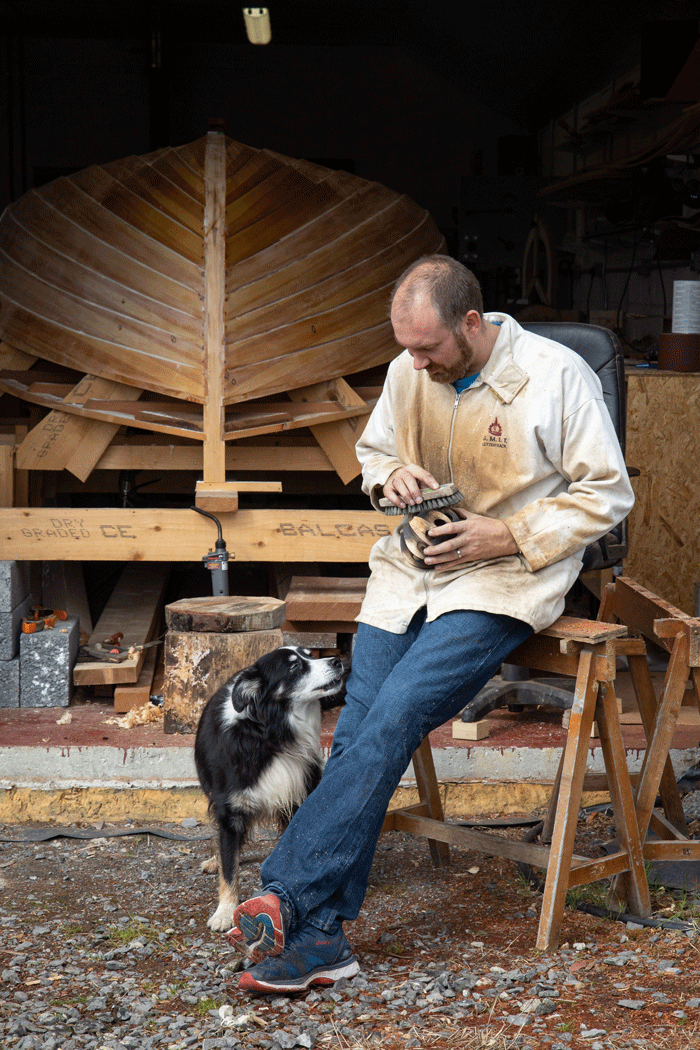
Ireland’s Max Brosi is one of the most inventive and eye-catching woodturners to emerge in recent years. The range of his work is quite remarkable, from fantastic abstract sculptures to deliciously tactile fullbellied vessels. He is a deep thinker about his craft and is renowned both for the ingenuity of his designs and for having the technical prowess to bring them into being.
Early experiences
Max was born in Germany; at the age of two, he moved with his parents to the northwest of Ireland. An only child growing up in the countryside, he remembers carving walking sticks and making bows and arrows with his penknife, and arrowheads from roof slates, “learning how materials work.” At age four, Max was playing with a hammer and saw at his grandfather’s workbench.
After school, he enrolled in Letterfrack Furniture College in Connemara. He loved the place, reveling in the hands-on designing and making. There were three installments in his education there, as he progressed from certificate to degree to a teaching qualification. In the periods between each stage, he did a lot of living, including travels in Central America and training as a diving instructor in County Kerry. He worked for a local furniture maker, producing one-off Max Brosi Roger Bennett furniture pieces, built-in wardrobes, and fitted kitchens. This was good experience and he enjoyed it, but he longed for the opportunity to develop and create work to his own designs.

Photo: Kurt Brosi
Woodturning was not on the curriculum in Letterfrack, but Max found a video of Mick O’Donnell turning thin green bowls and was amazed by his work. A photo in a library book of a sculptural piece by Michael Peterson, carved and sandblasted like the layered rocks in California’s Sandstone Canyon, opened his eyes to what could be made from wood. He had a go on an old Graduate lathe in the Letterfrack workshop, grinding gouges to profiles he had seen in the video. His first bowl, he says, was “abysmal,” but undeterred he later bought his first lathe with the initial idea of making three-legged stools to sell in the local market.
Get a glimpse into Brosi’s
design process in our new
Designer’s Notebook.
The business he started after graduating was very different, however. Combining his two loves of surfing and woodworking, he set up Cedar Surfboards, making “retro-shaped” hollow boards from Canadian cedar. These were beautifully made, “like a Bentley, not a Ferrari,” and he targeted the connoisseur market. Again, this was valuable experience, but when he was hi by the economic recession, he decided to qualify as a woodworking teacher.
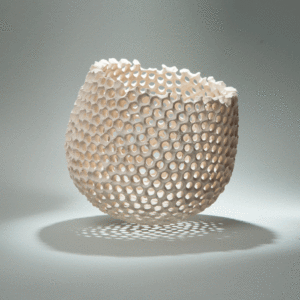 Photo: Steve Rogers |
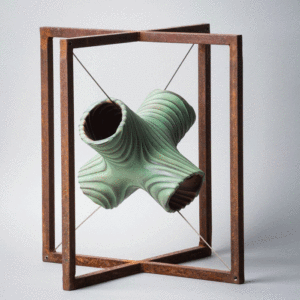 Photo: Steve Rogers |
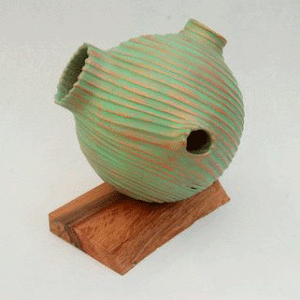 |
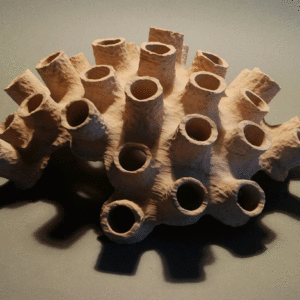 |
It wasn’t until Max started teaching woodturning that he really began to give the craft proper attention: “You have to be so clear in how you communicate it.” It was mostly self-instruction, gradually acquiring and refining skills and techniques. A one-day lesson with master turner Glenn Lucas was highly informative, showing him in particular how to position his feet and body correctly. Unlike Glenn, who produces beautiful salad bowls in batches of hundreds,Max focuses on one-off pieces: repetition does not appeal to his restless spirit, and he relishes the challenge of experimentation.
Finding his voice
Linking all of Max’s diverse forms is his preoccupation with texture. He uses locally sourced woods—ash, spruce, oak, cypress, leylandii—which he turns green, excited by the movement in the wood as it dries. Max values “the honesty of turning a form and leaving it to develop, without forcing it to conform to what is expected.” He loves the textures created by the drying process, how natural irregularities in the wood become accentuated. For example, in green oak: “The little pips and the rays in the sapwood become three dimensional rather than remaining a smooth flat surface.” In contrast to this minimal approach to surface treatment, he made an early series of delicate pieces inspired by the texture of coral, which he turned, carved, sandblasted, and bleached.
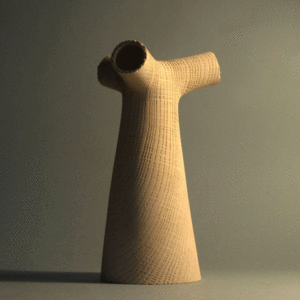 |
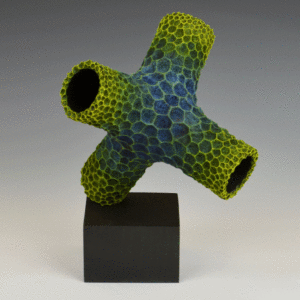 Photo: Bob Rotche |
Ideas started to flood in; Max says he was lucky to hit on forms that other people hadn’t created. One of these, his multiaxis tubular series, began quite innocuously. Wanting to make something truly minimal, he turned a simple hollow cylinder. But, dissatisfied with its appearance (he thought it looked no more interesting than the cardboard insert of a toilet paper roll), he took to his sketch book. How about a cylinder with another one coming out of the side?
Rise of the Machines (2013) was one of the first of Max’s multiaxis piecesexploring “the seamless interconnection of geometric shapes” to come from this “penny-dropping moment.” It was a tetrahedron turned from spruce, the product of much planning and experimenting. The surface treatment, too, was new for him. He tried sandblasting it, to little effect, so he then charred and brushed it, and took the final blackened layer off with sandblasting. The result was a lovely silky surface. Suspended in a rusty steel cage, the piece represents the negative consequences for the natural world of the rise of industrialization, with the feminine curves of the tetrahedron imprisoned in the harsh masculine cage. Rise of the Machines was a very significant piece in Max’s career: it brought him to the attention of the American turning community for the first time when it was selected for the Rising exhibition at AAW’s 2014 Symposium in Phoenix. The following year, it won first prize in the Open category at the Irish Woodturners Guild annual seminar.
Check out more great turning content
here on FineWoodworking.com
Other pieces followed, variations of this shape. Baobab is a stylized interpretation of a Madagascar baobab tree. He collaborated with Virginia wood artist Bob Rotche to make Tubularis Brosii for the AAW 2019 benefit auction. Max turned the piece from beech, and Bob covered its surface with an intricate pattern of carved recesses and colored it with acrylic paints. Mounted at an angle on a black block, it seems to be dancing and waving joyously. Kraken, a thirty-axis sculpture in green beech, was included in the AAW’s Turning 30 commemorative exhibition in Atlanta 2016. Evoking a mythical sea monster, it was very challenging to make: he had to devise a new tool and a holding device to enable him to turn each of the thirty little tubes.
Sometimes inspiration is subconscious. In 2014, Max suffered a sad loss when his father died suddenly from a heart attack. Only later did Max realize that a little spherical piece he called The Little Prince, which he initially thought of as an abstract sculpture with three short tubes emerging from it, was actually aortashaped, a working out of his grief.
Bolt series
In 2015, Max made his first piece in what would become his Bolt series: Society, a tube with side flanges turned from green oak, cut in half longitudinally, allowed to dry, and joined together with rusty bolts. As they dried, the two halves warped, so that when they were bolted together the join was anything but seamless, creating an underlying tension. The movement in the wood gives the piece life and dynamism, as Max explains: “It’s the energy of the two separate halves rejoined that interests me.”
 Photo: Tib Shaw/AAW |
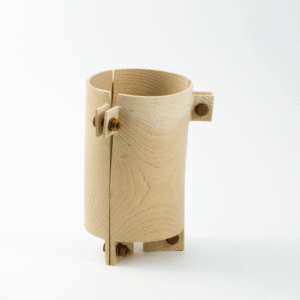 |
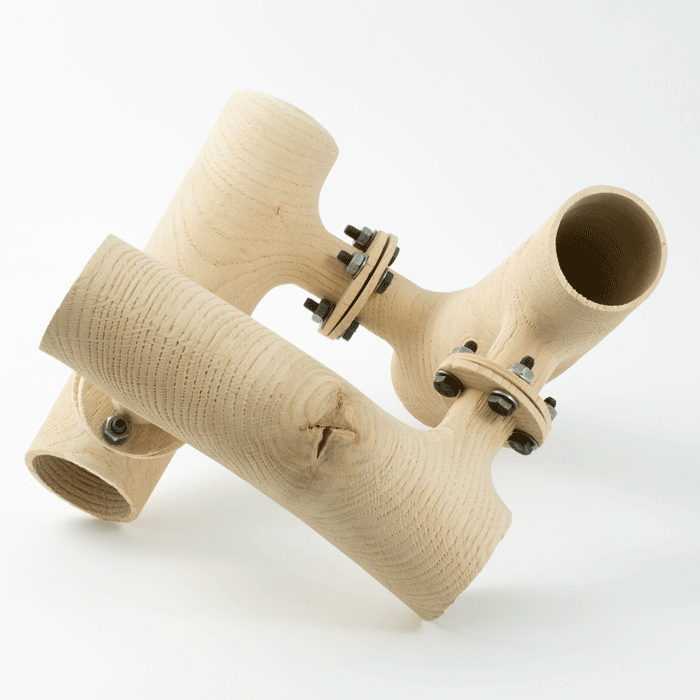
He developed this idea brilliantly by turning components that each have two or more tubes interconnected at right angles; after they have dried, he sandblasts them and bolts the ring flanges together. They have to be turned precisely so that the sections will line up correctly. Max notes that “the aesthetic is strongly influenced by driftwood, and by rusty old ships’ boilers found along storm beaches on the Irish Atlantic coast.”
He often uses pieces in the Bolt series to suggest narratives that allude to particular societal stories or controversies. The Irish Water sculptures (2015-) reference a debate then raging in Ireland over the introduction of domestic water charges by the government, the dysfunctional nature of the scheme expressed by the imperfect look of the forms. One of these, Irish Water 2, won the Established Maker Award in the 2015 Royal Dublin Society Craft Awards Exhibition. These pieces consist of two or three components, each turned on two or three axes. The minimalist sculpture Freedom of Speech is Max’s silently eloquent response to the Charlie Hebdo terrorist attack in Paris, January 2015—a simple cylinder with two side flanges bolted together: “I laid out the piece in the log in such a way that as the wood dried, the annual rings would contract and the beak would open. The rusty bolts represent the attempted suppression of the freedom of speech, holding the beak shut.”
All of Max’s multiaxis forms are carefully planned beforehand, the steps drawn and written down, the pieces already made in his head. His earliest tubular sculptures were initially turned from a cube (very dangerous); then he tried calculating and cutting a dodecahedron on a table saw; and finally he figured out how to use a sphere as his starting shape. The major problem was how to find the vertices of the tubes, and he spent days working out a mathematical formula to determine the position of the centers of the tubes on the sphere’s surface.
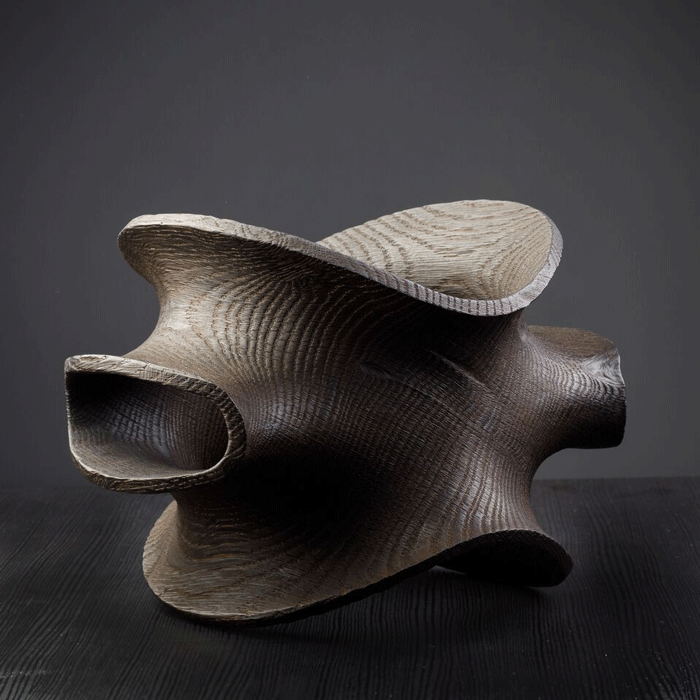
Photo: Steve Rogers
Organic forms
In 2015, Max had a serious accident, when he fell twenty-six feet from a climbing wall and suffered multiple fractures. He spent several months laid up, frustrated but feeling lucky not to be permanently disabled. When he eventually got back to the lathe, with “some of the thoughts and ideas generated in a notebook in a hospital bed, slowly spilling out and taking three-dimensional form,” he found that his shapes were becoming less geometric, more “curvy” and organic.
Alien Ocular, turned from green sycamore on four axes, is an early example of this more rounded abstract form. Six mouths agape separated by intersecting coves, hollowed with perfectly even wall thickness, it exudes a sense of otherworldliness. And from a technical standpoint, it is head-scratchingly amazing.
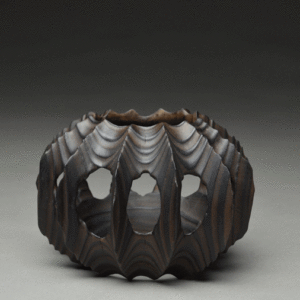 Photo: Tib Shaw/AAW |
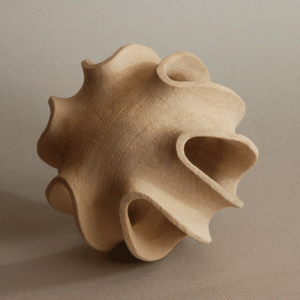 Photo: Steve Rogers |
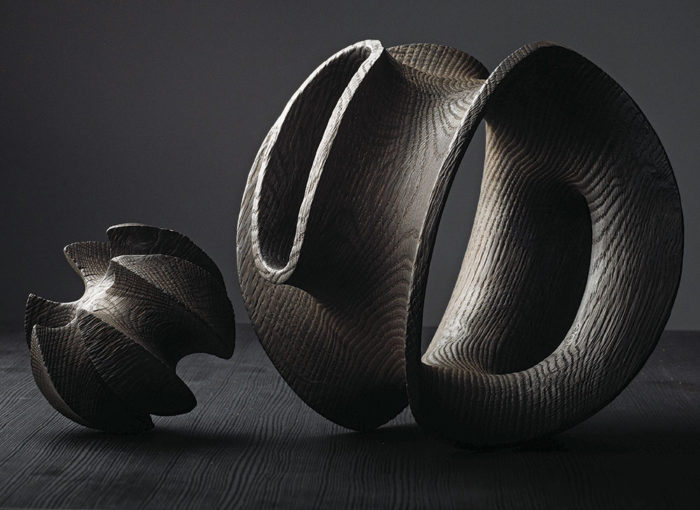
For the tubular pieces, Max does not have to do much carving, just smoothing the surfaces of the tubes where they meet using an Arbortech carver for the rough work and rotary burrs for the finish. The organic forms, on the other hand, are 80% to 85% turned, and the rest is carved, though the carving does take a lot of time, blending interior and exterior curves together. Max aims for an even wall thickness throughout, trusting his fingers to tell him when he has done enough.
Max reckons his head was full of bone imagery after his accident. Part of his childhood was spent in Easkey on the Sligo coast, and he regularly came upon whale vertebrae washed up on the beach. His Whalebone pieces certainly do conjure up such shapes, albeit heavily stylized—just as his tube pieces were never intended to mimic plumbing fittings, but are primarily explorations of simple geometric shapes. They are pieces for the imagination to feast on. Max himself says of one such sculpture that depending on its orientation, he is reminded variously of whale vertebrae, or a samurai helmet, or a spaceship.

Photo: Lothar Göbel
For Traces of Atlantis, exhibited and sold in the 2019 AAW POP auction Traces, Max set himself the challenge of turning the whole piece with no carving, “to create an organic form that resembles what I imagine past life forms from the lost city of Atlantis to look like. I wanted the form and texture to communicate age, erosion, and its organic nature.”
On texture and form
In addition to his complex multiaxis turnings, Max found himself drawn to “simple and straightforward woodturning” after his climbing accident, turning unadorned bowls and vessels from green woods. He usually prefers not to sand off the tool marks, liking their “honesty” (a core word in Max’s philosophy of making), as this shows the maker’s hands at work. As always in his pieces, the tactile quality of the texture is very important. He remembers after a demo in Spain, noticing a woman who was cupping a brightly colored vessel in her hands and stroking it gently: he realized that for her, the main attraction was the feel of the piece, its shape and texture. Max consciously started a series of pieces that could be appreciated by people with limited or no sight. He decided sandblasted oak is not very satisfying to touch because the blasting leaves sharp bits on the surface, whereas woods such as cypress, Sitka spruce, or leylandii, charred and brushed, have both the look and feel of old leather—rich terrain for the fingers to explore.
FINDING GOOD FORM |
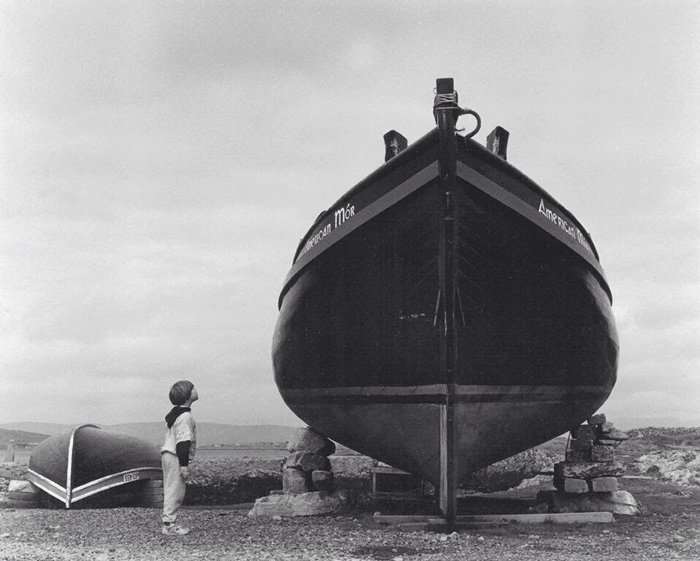 |
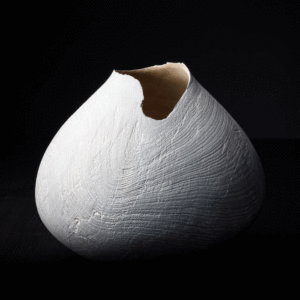 |
The front view of a Galway hooker (“An American Mór,” Carraroe Hooker, 1992, above) has inspired Max’s sense of form. It encapsulates much of his thinking about well-shaped vessels. Photo: Bob Quinn
|
And of course the shape must be good. When Max was young, he often accompanied a German artist friend to the beach on a pebble hunt. Lothar Göbel makes sculptures from pebbles, cutting them in half and gluing a band of glass between the two sections. The pebbles have to be perfectly elliptical, and Max learned a lot from these searches: he loved the feel of the pebbles, their textures and shapes.
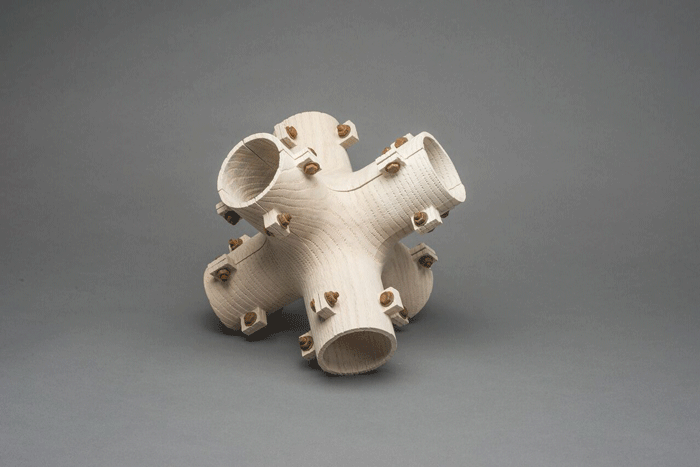
Photo: John Carlano
Over the years, Max has refined his opinion of the “right” profile. The widest part of a pebble is usually in the middle and therefore it is rather static: having the widest point below the center elevates the piece, gives it a sense of dynamism. So, take the pebble shape, “pucker in the bottom, lower the wide point, taper the top.” The front-on profile of a Galway hooker, a traditional West of Ireland sailboat, excites him, and he will sometimes place one of his Pebble Vessels beside a photograph of the boat to compare their shapes.
Max particularly admires the shapes made by turners such as Liam Flynn, Christoph Finkel (“his calabash bowls—the proportions are bang on!”), Ernst Gamperl, and Friedmann Buehler. Occasionally, he incorporates multiaxis techniques into his vessel making, as in the Melting Pot series, a four-axis bowl form with three semi-circular protrusions in the rim, like pouring lips.
Recognition
Recognition, both in Ireland and internationally, came quickly for Max. His designs are innovative, his techniques intriguing, and he is regularly in demand as a demonstrator, notably at Jornados con La Madera in Spain, and at the international seminars of the Irish Woodturners Guild, the Association of Woodturners of Great Britain, the Association Française de Tournage d’Art sur Bois, and the AAW (where he won an Excellence Award in the Instant Gallery in 2015). Max works as a Furniture Design Tutor at a third level college, Cavan Institute, and his teaching experience is invaluable when demonstrating the intricacies of his turning techniques. His work has been included in AAW exhibitions, at SOFA Chicago (Collectors of Wood Art’s Why Wood exhibition in 2016), and in exhibitions at Beatrice Wood Center for the Arts (represented by Kirsten Muenster). In May 2019, he had a solo exhibition with the online Wood Symphony Gallery.
Max lives in a most beautiful place, but it is quite remote, so he enjoys the opportunity to exchange ideas and techniques at seminars and demos, and also during his visits to and sojourns with other wood artists such as Jacques Vesery and fellow multiaxis practitioner Barbara Dill. In 2017, he took part in the International Turners’ Exchange (ITE) at The Center for Art in Wood in Philadelphia, where he was inspired by the other participants, the city environment, visits to the homes of woodturners and collectors, the variety of woods,
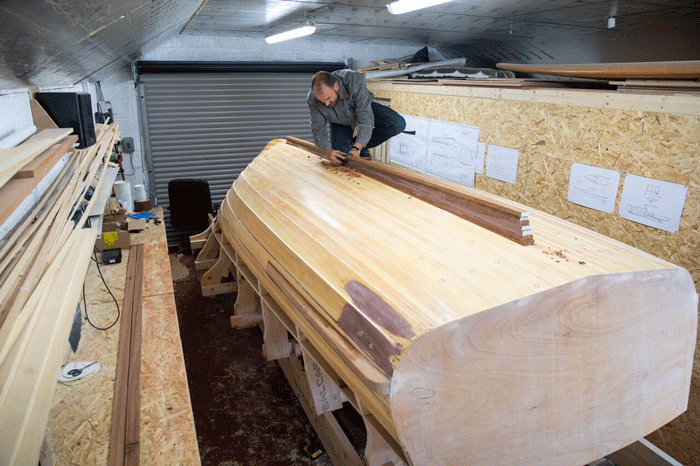
the feedback from visitors, the positive attitude in America to wood art, and the openness and generosity of everyone involved. Max encapsulated the experience in the multiaxis Bolt sculpture Us…Here…Now…, whose components represent the participants, bolted together by the experience.
Other interests
Max has such a wide range of interests that he finds it difficult to get time for all of his projects. In 2009, with his wife Anna Marie, he designed and built their home, a quietly dramatic timber house on stilts with a butterfly roof (see tiny.cc/Brosihouse). His social media followers are fascinated by his regular posts charting the progress of the 17′ (5.2m)
boat he is building, their vocabulary enriched with the poetry of nautical terms such as sheerstrake and breasthook. And now, there is Max Brosi the potter: he has added a
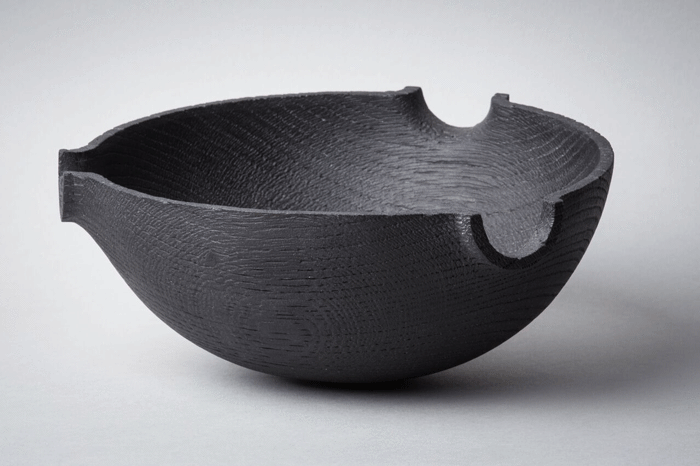
Photo: Steve Rogers
ceramics room to his studio, dug a fire pit, and made some fine bowls and vessels using clay from his own land.
What’s next for Max Brosi? At the ITE Exchange, Albert LeCoff wisely cautioned him against expecting instant epiphanies, and Max says it took several months for the new ideas
he absorbed there to begin seeping into his work. One example is the use of milk paints and other methods of coloring. Max’s interest in ceramics, especially the Japanese wabi sabi aesthetic, is starting to influence his thinking about shape and surface. But whatever he does, it is sure to be interesting, honest, and well done.
Roger Bennett is an Irish woodturner and occasional writer. He specializes in making bowls, vessels, and jewelry, which he colors and inlays with silver. In a previous life, he was a teacher of English and French. For more, visit rogerbennettwoodturner.com.
Brought to you by:
 |
|
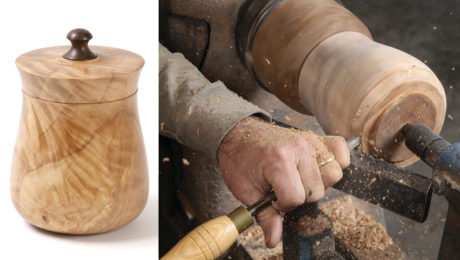 |
|
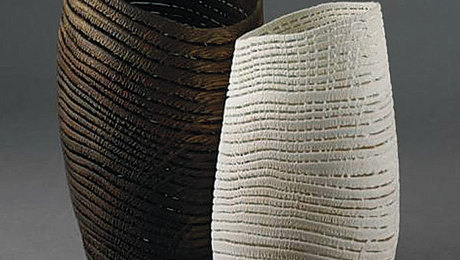 |
Fine Woodworking Recommended Products
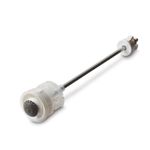
CrushGrind Pepper Mill Mechanism

Drafting Tools

Dividers
















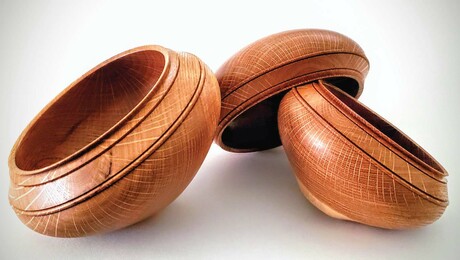








Log in or create an account to post a comment.
Sign up Log in